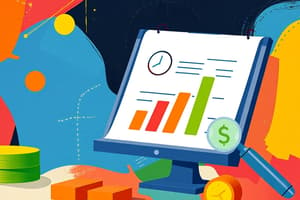Podcast
Questions and Answers
discuss the meaning of cost and mention various concepts related to the costs
discuss the meaning of cost and mention various concepts related to the costs
Fixed Cost
What type of cost changes depending on the production level?
What type of cost changes depending on the production level?
Variable Cost
What is the term for costs directly associated with producing a product or service?
What is the term for costs directly associated with producing a product or service?
Direct Cost
What type of analysis compares the costs of a decision to its potential benefits?
What type of analysis compares the costs of a decision to its potential benefits?
What is the term for the value of the next best alternative given up when choosing one option over another?
What is the term for the value of the next best alternative given up when choosing one option over another?
What type of costing allocates fixed and variable costs to products or services?
What type of costing allocates fixed and variable costs to products or services?
What is the term for reducing costs by increasing production volume?
What is the term for reducing costs by increasing production volume?
What is the term for reducing costs through experience and efficiency gains?
What is the term for reducing costs through experience and efficiency gains?
What is the primary goal of cost analysis in a business?
What is the primary goal of cost analysis in a business?
What does the concept of opportunity cost refer to?
What does the concept of opportunity cost refer to?
What is the difference between fixed and variable costs?
What is the difference between fixed and variable costs?
What is the purpose of cost-benefit analysis?
What is the purpose of cost-benefit analysis?
What is the term for the reduction in costs achieved through increased production volume?
What is the term for the reduction in costs achieved through increased production volume?
Flashcards are hidden until you start studying
Study Notes
Types of Costs
- Fixed Costs: Expenses that remain the same even if the business produces more or less. Examples: rent, salaries, insurance.
- Variable Costs: Expenses that change depending on the production level. Examples: raw materials, labor, marketing.
- Semi-Variable Costs: Expenses that have both fixed and variable components. Examples: utilities, maintenance.
Cost Classification
- Direct Costs: Costs directly associated with producing a product or service. Examples: labor, materials.
- Indirect Costs: Costs not directly associated with producing a product or service. Examples: overhead, administrative expenses.
- Opportunity Costs: The value of next best alternative given up when choosing one option over another.
Cost Analysis
- Cost-Benefit Analysis: Comparing the costs of a decision to its potential benefits.
- Cost-Volume-Profit (CVP) Analysis: Analyzing the relationship between costs, volume, and profit to make business decisions.
- Break-Even Analysis: Determining the point at which revenue equals total fixed and variable costs.
Cost Accounting
- Absorption Costing: Allocating fixed and variable costs to products or services.
- Marginal Costing: Allocating only variable costs to products or services.
- Standard Costing: Comparing actual costs to predetermined standard costs.
Cost Behavior
- Economies of Scale: Reducing costs by increasing production volume.
- Diseconomies of Scale: Increasing costs due to inefficiencies in large-scale production.
- Learning Curve: Reducing costs through experience and efficiency gains.
Types of Costs
- Fixed Costs: Remain the same despite changes in business production, e.g. rent, salaries, insurance.
- Variable Costs: Change depending on production level, e.g. raw materials, labor, marketing.
- Semi-Variable Costs: Combine fixed and variable components, e.g. utilities, maintenance.
Cost Classification
- Direct Costs: Directly relate to producing a product or service, e.g. labor, materials.
- Indirect Costs: Not directly related to production, e.g. overhead, administrative expenses.
- Opportunity Costs: The value of the next best alternative given up when choosing one option over another.
Cost Analysis
- Cost-Benefit Analysis: Compares costs of a decision to its potential benefits.
- Cost-Volume-Profit (CVP) Analysis: Analyzes relationships between costs, volume, and profit for business decisions.
- Break-Even Analysis: Finds the point where revenue equals total fixed and variable costs.
Cost Accounting
- Absorption Costing: Allocates fixed and variable costs to products or services.
- Marginal Costing: Allocates only variable costs to products or services.
- Standard Costing: Compares actual costs to predetermined standard costs.
Cost Behavior
- Economies of Scale: Reduces costs by increasing production volume.
- Diseconomies of Scale: Increases costs due to inefficiencies in large-scale production.
- Learning Curve: Reduces costs through experience and efficiency gains.
Cost Concepts
- Cost refers to the expenditure or sacrifice made to achieve a particular objective.
Types of Costs
- Fixed Costs: remain the same despite changes in production levels, e.g., rent, salaries, and insurance.
- Variable Costs: change depending on production levels, e.g., raw materials, labor, and marketing.
- Semi-Variable Costs: have both fixed and variable components, e.g., utilities and maintenance.
Cost Classification
- Direct Costs: directly associated with producing a product or service, e.g., labor and materials.
- Indirect Costs: not directly associated with producing a product or service, e.g., overhead and administrative expenses.
- Opportunity Costs: the value of the next best alternative given up when choosing one option over another.
Cost Analysis
- Cost-Benefit Analysis: compares the costs of a decision to its potential benefits.
- Cost-Volume-Profit (CVP) Analysis: analyzes the relationship between costs, volume, and profit to make business decisions.
- Break-Even Analysis: determines the point at which revenue equals total fixed and variable costs.
Cost Accounting
- Absorption Costing: allocates fixed and variable costs to products or services.
- Marginal Costing: allocates only variable costs to products or services.
- Standard Costing: compares actual costs to predetermined standard costs.
Cost Behavior
- Economies of Scale: reducing costs by increasing production volume.
- Diseconomies of Scale: increasing costs due to inefficiencies in large-scale production.
- Learning Curve: reducing costs through experience and efficiency gains.
Studying That Suits You
Use AI to generate personalized quizzes and flashcards to suit your learning preferences.




